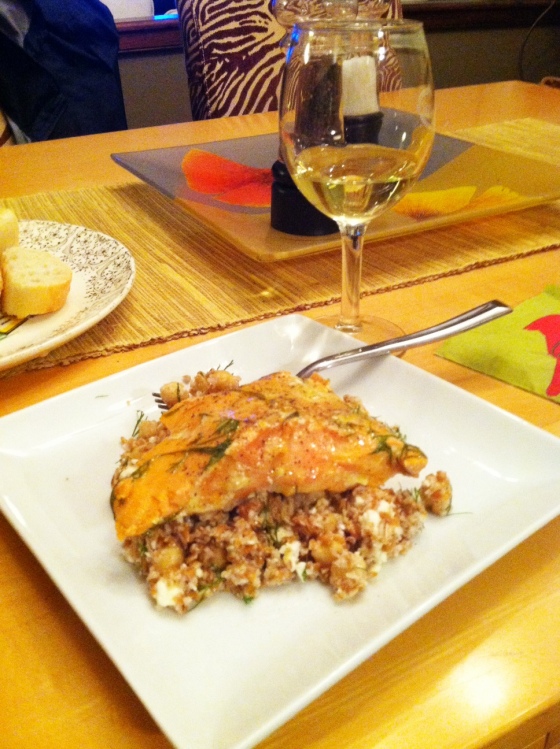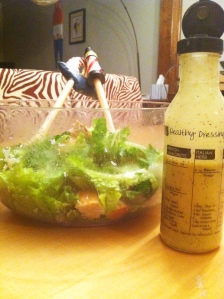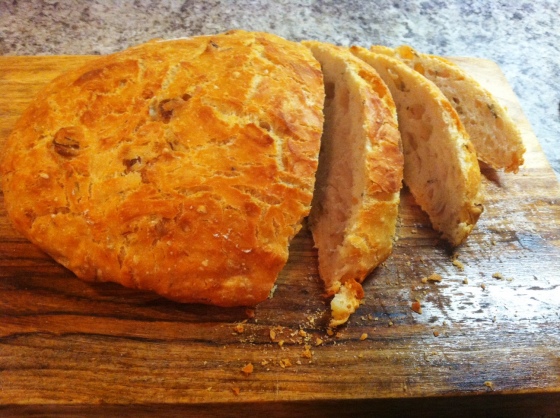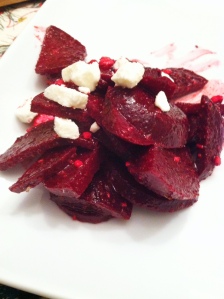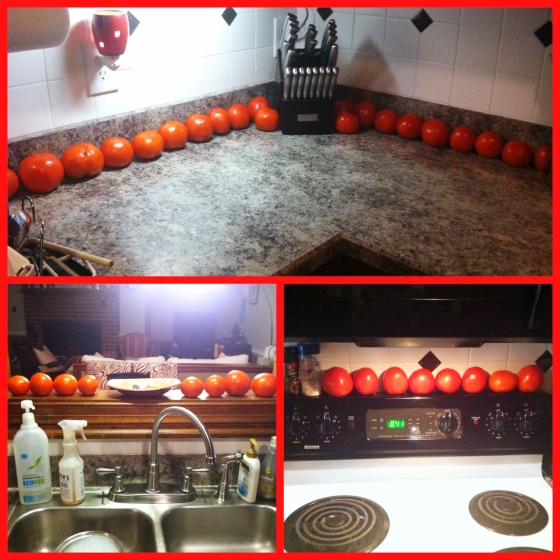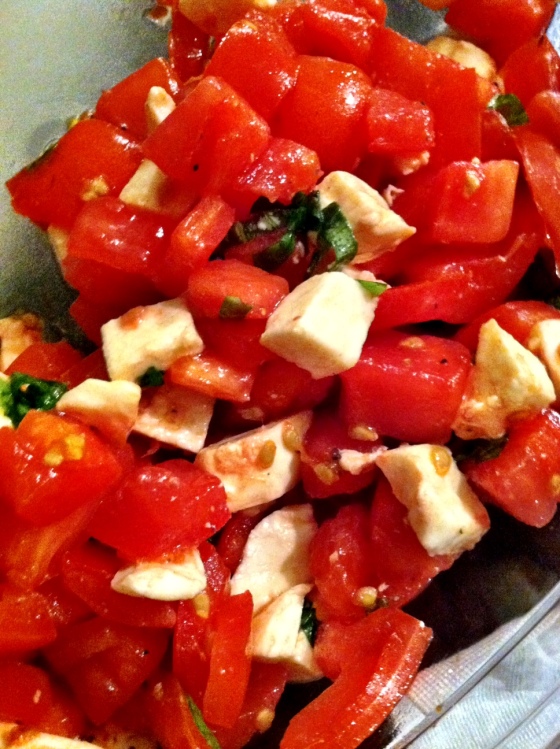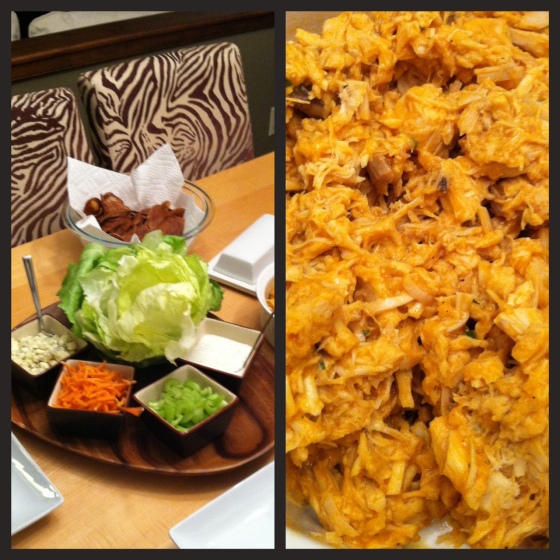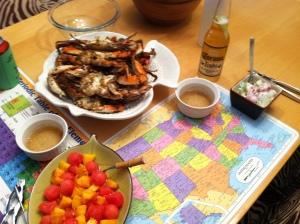Sometimes you’re making dinner and you realize you don’t really have a side dish and you just have to improvise. Farm fresh tomatoes and cucumbers sliced up with artichokes, parsley and drizzled with lemon juice, olive oil, red wine vinegar and salt and pepper.
Tag Archives: salad
I’m still eating
I’m still alive, I’m still cooking and please believe I’m still eating. We are currently in between houses – we sold our townhouse but have yet to move into our new house. So we are living it up at my parents! It’s actually much better than you’re imagining but while I’m here and paying no rent I’m making my payments in food. Both of my parents and Jeremy work long hours on top of an hour long commute, each way, which means I’m eating alone a lot, which is not my favorite but gives me an excuse to eat nothing but lettuce, heirloom tomatoes, feta and wine. Can’t wait to start posting from my new, amazing kitchen!
Pantry Raid IV: better bulgur
Bulgur sounds gross, and I get that. But it’s really not. Bulgur is parboiled cracked wheat berries. It’s a super whole grain with a wonderful nutty taste. It also has a great texture that I can only describe as “toothsome.” It isn’t hard, but even after being soaked, it has tooth – like very good al dente pasta. Just one cup of bulgur has over 25 grams of fiber and over 17 grams of protein. And incidentally, I had a huge bag of it in my cabinet that I needed to start working on getting rid of.
Bulgar, like quinoa, is a great base for salads. This bugar salad recipe came from Everyday Food, and it’s really light and delicious and keeps well. Make it at the beginning of the week, measure it out into individual containers and then grab them for a healthy lunch on the go. This recipe makes a lot – like most grains, just one cup, once cooked, makes a huge amount of food and because it is high in fiber and protein, you don’t need to eat much to get full. I made this salad for dinner with a yummy marinated salmon and still had enough left over for lunch several days that week. This salad also incorporates chick peas (or Garbanzo beans – whichever name you prefer). Chick peas are also full of protein, so you really can’t go wrong here. Leave out the feta for a (still delicious) Vegan side dish.
Bulgur and Chick Pea Salad
Ingredients
- 1 cup bulgur
- 2 cups boiling water
- 1 can (15.5 ounces) chickpeas
- 1 tablespoon lemon zest and 2 tablespoons juice
- 3 tablespoons extra-virgin olive oil
- 1/4 cup roughly chopped fresh dill
- 1/2 cup crumbled feta (2 ounces)
- Salt and pepper
Directions
- In a large bowl, combine bulgur with boiling water. Cover and let stand 20 minutes; drain and return to bowl. Rinse and drain chickpeas, then add to bowl with lemon zest and juice, olive oil, dill, and feta; season with salt and pepper.
For the salmon, I combined a little olive oil, a dash of white wine vinegar, the juice of half of a lemon, some dill, salt and pepper and put the salmon into some tin foil, made a pouch, poured the marinade over the salmon, wrapped it up really good and baked at 375 for about 15 minutes. It was perfect together and it would be a crime to eat this meal without a glass of good Chardonnay. So don’t let the name throw you off, replace that pasta side dish with a healthier bulgur alternative.
The possibilities here are endless – Greek bulgar salad with grilled chicken, feta, cucumbers, tomatoes and kalamata olives; bulgar and lentil salad with grapefruit vinaigrette, breakfast bulgar with maple syrup and baked apples . . . OK, I’m starting to sound like a bulgur growing Bubba from Forrest Gump. You get the picture.
the other green
I was reading a story in Edible Piedmont this morning about a kale recipe, which could also be made with collards. The author made this substitution because she said she knew how popular collards are in eastern North Carolina, so much so that the region has been referred to as “The Collard Belt.” I’ll take it. But I’ll also take kale. Any day of the week. I think it’s actually a bit more palatable to the general population than collards and is usually cooked in more various ways.
I know it’s sort of cliche to have a food blog and regale the benefits of kale. Everyone gets it, I know. Kale is great, it’s good for you, it’s a super food, put it in your smoothies, bake it into cookies, blah blah blah. But seriously. It’s great. So great that I highlighted one of my favorite kale recipes in my January column in Tidewater Women. The column this month is about resolving to “Live Locally” and what that means, how it benefits not only you personally, but your community as a whole. I also put it in there to remind people that local food isn’t in hibernation during the winter months. It’s readily available, if you’re willing to look for it, and to try something you might not otherwise try (ie – kale. or chard. or other things that are green and look like dinosaur food.) Not wanting to be a hypocrite, I went out yesterday, tracked down some kale and made this recipe, which I share with you below. It really is a great recipe, especially for the new year, if (like me) you are trying to drop a few “party pounds” from the holidays….this meal is so packed with protein that after only half a bowl you’ll feel completely full. It’s also so lo-cal and healthy that even if you down all four servings in one night, there’s really nothing to feel guilty about. Except for the amount of flatulence you will inevitably plague your family with if you decide to do that. ANYWAYS.
I found this kale at a little roadside stand out in front of somebody’s house. These are my favorite places to shop because it’s fresh, you’re helping support someone’s backyard gardening habit, and the produce is usually dirt cheap. I got a pound of kale and a dozen fresh, free-range eggs for $4. I could also have scored 4 lbs of sweet potatoes for a dollar if I’d liked. Keep an eye out for these stands in your neighborhood or town. And don’t feel shy or weird about driving up to them. The people who set them out are usually so nice and happy to have a customer. The chicken came from a Crock Pot Chicken I’d made earlier in the week. This was one of three meals I got out of one five pound chicken. The only change I make in this recipe is that I use dried lentils that I cook and season myself. I’ve never been able to find canned lentils in my grocery stores, but if your store has them – more power to you. If you go this route, use half the bag (1/2 lb) – not two whole cups of dried beans, as they will expand as they cook. 1/2 lb will give you just over two cups once cooked.
Shredded Chicken with Kale and Lentils
Ingredients:
- 2 tablespoons extra-virgin olive oil
- 1 small onion, finely chopped
- 1 teaspoon fresh thyme leaves
- Coarse salt and ground pepper
- 2 bunches kale, tough stems removed, torn into bite-size pieces
- 2 cups lentils (from a 15.5-ounce can), drained and rinsed
- 2 cups shredded cooked skinless chicken breasts
- Lemon wedges, for serving
Method:
- In a large skillet, heat 1 tablespoon oil over medium heat. Add onion and thyme; season with salt and pepper. Cook, stirring occasionally, until onion is softened, about 5 minutes.
- Add kale and cook, stirring occasionally, until kale is wilted and tender, 4 to 6 minutes. Transfer to a medium bowl.
- Add 1 tablespoon oil and lentils to skillet; season with salt and pepper. Cook, stirring, until warmed through, about 20 seconds. Transfer to bowl with kale, toss to combine, and divide among four bowls. Top with chicken and squeeze lemon over top. Serves 4.
I agree with what you’re thinking – this looks like a recipe you see in those magazines all about getting fit with advertisements for muscle milk supplements. But honestly, it doesn’t taste like that. It tastes yummy AND healthy, which is possible, I promise. Jeremy even got seconds. Flatulence be damned!
Pinterest Perfection
I’m sure many, if not most, of you have heard of Pinterest. I first heard about this little site where you could “curate” your own visual boards over two years ago when the site was still in Beta testing. I did some quick research on the trusty interwebs and lo and behold, I was able to track down the Pinterest CEO to his person twitter page, where I began a barrage of direct messages begging for a beta tester invite. I got it. His name is Ben, by the way, and he’s super nice. I was one of the first few thousand people to use the site, and use it I did. I currently have over 30 boards, 981 pins and 125 followers. When Pinterest first started it was much more of an art and design crowd. The cool kids who were developing the site had no doubt invited their other cool kid friends who I’m sure were all interior designers, graphic artists, and web developers in San Francisco (that’s where the company is based, not the valley, which is why the site and its people are so cool) to give it a whirl. As Beta opened up to user invites, and the site became a real, live thing, it became much, much, much more crafty, crock potty and crap to do with your kidsy. But you know what? I still love it. Despite the fact that I have to sift through hundreds of pins of maternity photo sessions to get to the thing I’m looking for, despite the fact that when I search the food category I have to ignore a million recipes that suggest throwing four different kinds of canned Campbell’s crap into your slow cooker and feeding it to your family of 10 for less than .30 cents a serving, I still think it is an awesome, amazing thing. And every once in awhile, you run across some real gems.
on the trusty interwebs and lo and behold, I was able to track down the Pinterest CEO to his person twitter page, where I began a barrage of direct messages begging for a beta tester invite. I got it. His name is Ben, by the way, and he’s super nice. I was one of the first few thousand people to use the site, and use it I did. I currently have over 30 boards, 981 pins and 125 followers. When Pinterest first started it was much more of an art and design crowd. The cool kids who were developing the site had no doubt invited their other cool kid friends who I’m sure were all interior designers, graphic artists, and web developers in San Francisco (that’s where the company is based, not the valley, which is why the site and its people are so cool) to give it a whirl. As Beta opened up to user invites, and the site became a real, live thing, it became much, much, much more crafty, crock potty and crap to do with your kidsy. But you know what? I still love it. Despite the fact that I have to sift through hundreds of pins of maternity photo sessions to get to the thing I’m looking for, despite the fact that when I search the food category I have to ignore a million recipes that suggest throwing four different kinds of canned Campbell’s crap into your slow cooker and feeding it to your family of 10 for less than .30 cents a serving, I still think it is an awesome, amazing thing. And every once in awhile, you run across some real gems.
On Wednesday of this past week, I made THREE recipes for one meal that I found on Pinterest: A Roasted Garlic salad dressing, a rosemary and Parmesan overnight bread, and an Italian style beef and butternut squash stew. They were all the kind of things that keep me obsessed with the site. Diamonds in the rough.
The Roasted Garlic Vinaigrette is a MUST try to anyone who loves garlic on the level that I do. Two heads of garlic go into this dressing. And while you do have to roast the garlic for a good half hour, the dressing itself is really easy to make, and you probably have most of the ingredients on hand. I’m currently obsessed with making my own salad dressings and have tried several I’ve found on Pinterest, but this one is my favorite.
From Fat Girl Trapped in a Skinny Body:
Roasted Garlic Vinaigrette
Ingredients:
- 2 heads of garlic, roasted and peeled
- 1/2 cup extra virgin olive oil
- 1/4 cup apple cider vinegar
- 2 tbsp lemon juice
- 1/2 tsp kosher salt
- 1 tsp black pepper
- 1 tbsp honey
Method:
- Cut the pointy top off of the garlic. Brush them with olive oil and roast them in a pan in the oven at 400 degrees for about 25 minutes, until it is starting to turn golden brown and soft. Remove from the oven, allow to cool. Once the garlic is cool, peel the skin off. Discard the skins, save the garlic. *Skin peels off really easily after they are roasted.
- Add all the ingredients to the food processor and process until smooth. Refrigerate until ready to serve.*If some of the skin get processed with the rest of the dressing, no big deal, it won’t change the flavor.
The salad dressing can be vegan if you sub the honey for agave. And it is dairy free, with no substitutions!
This dressing is tangy, but has that deep, rich caramelized taste from the roasted garlic. It’s a vinaigrette, but it’s creamy because of the garlic being processed right into it. Keep this for a week or so in your fridge in a covered container.
The bread recipe I comes from Simply So Good. I used her basic bread recipe, and put in my own additions. This bread is baked in your cast-iron enameled Dutch Oven (you have one of those, right??). I have a big, blue Le Creuset that is the Pride and Joy of my kitchen. Jeremy gave it to me for Christmas a few years ago. They are usually in the $300-$400 range, but sometimes you can score them at T.J. Maxx for half the price, which I believe is what he did (smartly). Other cast-iron enameled pots are fine for this recipe also, but when you have a Le Creuset, you tend to brag about it. Here is a view down on mine to give you an idea of the size of the vessel you might want to use:
OK, enough about my awesome piece of iron. Here’s the recipe.
Crusty Bread
Ingredients:
- 3 cups unbleached all purpose flour
- 1 3/4 teaspoons salt
- 1/2 teaspoon yeast
- 1 1/2 cups water
Method:
- In a large mixing bowl, whisk together flour, salt and yeast. Add water and mix until a shaggy mixture forms. Cover bowl with plastic wrap and set aside for 12 – 18 hours. Overnight works great.
- Heat oven to 450 degrees. When the oven has reached 450 degrees place a cast iron pot with a lid in the oven and heat the pot for 30 minutes. Meanwhile, pour dough onto a heavily floured surface and shape into a ball. Cover with plastic wrap and let set while the pot is heating.
- Remove hot pot from the oven and drop in the dough. Cover and return to oven for 30 minutes. After 30 minutes remove the lid and bake an additional 15 minutes. Remove bread from oven and place on a cooling rack to cool.
To this recipe, I added 1/4 cup of fresh grated Parmesan Cheese, 1/8 cup of fresh rosemary (from my garden), and several cloves of smashed and roughly chopped garlic. I added that in to the dough at the very beginning and then proceeded as normal through the recipe.
This thing turned out beautiful. There is nothing quite like making your own bread from scratch and this is really a pretty easy way to do it.
Finally, the main course – Beef and Butternut Squash Stew from Closet Cooking. I’ll be honest and say there are a few things wrong with the way this original recipe is written, so the recipe below has a few very minor changes from myself, just to make things more clear.
Italian Style Beef and Butternut Squash Stew
Ingredients:
- 2 ounces pancetta (diced)
- 1 pound beef (cut into 1 inch cubes) (My Note: he doesn’t specify what kind of beef to use here. My suggestion is to get a sirloin roast, if you can find one – that’s what I used. Otherwise a small round roast is fine or chuck if nothing else is available)
- 1 onion (chopped)
- 3 cloves garlic (chopped)
- 1/2 teaspoon red pepper flakes (optional, to taste)
- 1 tablespoon rosemary (chopped)
- 1 tablespoon thyme (chopped)
- 1 cup Italian red wine (My Note: I used a Zinfandel. It doesn’t have to be Italian, don’t stress out, just use a decent red wine that’s not sweet)
- 3 cups beef broth
- 1 splash balsamic vinegar
- 1/4 cup sundried tomatoes (chopped)
- 1 (28 ounce) can diced tomatoes (My Note: He doesn’t specify drained vs. undrained. Because he does not, I put them in without draining them. It gave my stew a more “soupy” consistency, which I was OK with. If you want this to be more like a traditional stew, then drain the tomatoes before adding).
- * parmigiano reggiano rind (optional)
- 1 teaspoon oregano
- salt and pepper to taste
- 1 pound butternut squash (peeled, seeded and cut into 1 inch cubes)
- parsley (chopped) (My Note: optional for garnish. I used a bit of grated Parmesan instead).
Method:
- Cook the pancetta in a large pan on medium heat. (My Note: or Dutch Oven. Again, with my Creuset)
- Add the beef and brown on all sides in the grease from the pancetta and set aside. (My Note: I coated the beef cubes in flour first. I’ve always done this when searing beef that is basically going to be braised later. It also helps to thicken the sauce a bit, but it’s up to you).
- Add the onion and saute in the pancetta grease until tender, about 5-7 minutes.
- Add the garlic, red pepper flakes, rosemary and thyme and saute until fragrant, about a minute.
- Add the wine and deglaze the pan. (My Note: deglazing means you add a liquid to absorb the browned bits from the pancetta, beef and aromatics. When you add the wine to the hot pan, it will steam up. Take a wooden spoon and use that moment to scrape up all the bits in the bottom of the pan, stirring them into the liquid to create a flavorful base).
- Add the beef, broth, balsamic vinegar, sun-dried tomatoes, diced tomatoes, parmigiano reggiano rind, oregano, salt and pepper and bring to a boil.
- Reduce the heat, cover and simmer until the beef is nice and tender, about 1-2 hours.
- Add the squash and simmer until it is tender, about 15-20 minutes. (My Note: more like half an hour, at best).
This stew was filling, hearty and really quite healthy. Serve it with a glass of the same wine you used in the soup – superb! Always cook with wine that is good enough to drink. When you cook with wine, you are cooking off the alcohol, but intensifying the flavor. If you intensify a crappy wine, you will just get really intense crap. No Bueno.
The dressing, served over a bed of Organic romaine lettuce, the garlic, rosemary and Parmesan bread and this stew altogether? Perfection. Pinterest Perfection.
The root of it all
I just gave myself an award for the most clever blog title ever.
It is a shame, I realized, that this blog’s namesake has never really been examined thoroughly. I think in my very first blog post I may have posted a picture of a beet dish I had done, but I’ve never really delved into this amazing little root that inspired me to make this blog. There are a few reasons that beets are the thing I happen to heart. They are available locally, they are available at several times throughout the year and many people don’t like them. Why is that a reason to make beets the central theme of a blog? Because I think I can change people’s minds. I think a lot of foods out there that deserve our attention but suffer general distaste have just been presented wrong all this time. Like the poor Brussels sprout, which I will post about later . . .
Take, for instance, my husband who insisted he hated beets. So I asked in what format he had experienced beets in the past and he said either canned, pickled or boiled to death. Well, no wonder. He also hated Brussels sprouts for similar reasons. But there is a simple answer to both of these food fears and it is this: roasting. Roasting, which uses dry, indirect and diffused heat (such as an oven) increases flavor by caramelization and the Maillard browning reaction. Essentially, roasting enhances the sugars in foods through a process called pyrolysis, which I will not get into, because I barely passed chemistry. But here is what I do know: it makes food delicious. Especially foods like beets, which already have a high natural sugar content, just waiting to be released.
Beets are also so nutritious. Here are some facts from Nutrition and You about beets:
- Beets are a rich source of phytochemical compound, glycine betaine. Betaine has the property of lowering homocysteine levels within the blood. Homocysteine, a highly toxic metabolite, promotes platelet clot as well as atherosclerotic-plaque formation, which, otherwise, can be harmful to blood vessels. High levels of homocysteine in the blood result in the development of coronary heart disease (CHD), stroke and peripheral vascular diseases.
- They are also a rich source of B-complex vitamins such as niacin (B-3), pantothenic acid (B-5), pyridoxine (B-6) and minerals such as iron, manganese, copper, and magnesium.
- The root has very good levels of potassium. 100 g fresh root has 325 mg of potassium or 7% of daily requirements. Potassium lowers heart rate and regulates metabolism inside the cells by countering detrimental effects of sodium.
And while us die-hard beet fans can eat a beet canned, pickled, boiled, grilled or anything else, for those skeptics out here, this is my GO-TO beet recipe. I’m not sure where it originated from…I think a friend may have suggested this method and I’ve just sort of made it my own over time, I’m not really sure. My hope is that you will love it enough to make it your own, adding, subtracting and substituting to your liking.
Roasted Beet Salad with Vinaigrette
- One bunch beets (as seen above)
- 3 tbs olive oil
- 1 tbs vinegar of your choice (balsamiq, red wine, champagne, whatever you like)
- 1 shallot, finely diced
- 1 tbs dried herbs (Italian, Herbs de Provence, fresh or powdered garlic or whatever else you’d like)
- Salt and Pepper to taste
- 1 cup crumbled feta cheese
Method:
- Pre-heat oven to 375 Fahrenheit. Cut the beets off their stems and trim off the tops and the “tails” of each beet. Clean each beet so they are free of dirt. Wrap each beet in individually in tin foil and place in the pre-heated oven, directly on the center rack. Roast for 30-40 minutes, or until each beet is easily pierced with a knife.
- While the beets are roasting, create your vinaigrette. The most important thing to remember here is the a vinaigrette dressing always 3 parts oil to 1 part vinegar. You can use any combination or any measurement (tsp, tbs, cup, etc), as long as you keep that ratio the same. Pour your oil, vinegar, shallots, herbs, salt and pepper into a medium sized bowl and whisk until they are emulsified. Set aside until beets have finished roasting.
- When beets are easily pierced with a knife, unwrap from tinfoil and allow to cool. Take an old dishtowel and peel the beet’s skin off with the towel – if it’s roasted to completion, the skin should slide off easily. Do this with each beet.
- Cut each beet in half or in quarters, if large, and cut into thin slices. Re-whisk your vinaigrette so it is well blended, then add your beets to the bowl and toss to coat. Plate, then top each serving with a spoonful of feta cheese.
If you don’t like beets like this, then I grant you the right to dislike beets. But before you file them away in things that are gross and that you refuse to eat, please try this recipe. Please. Give beets a chance.
Note: these beets were purchased from Westside Produce and Provisions where they were sourced from New Earth Farms in the Pungo area of Virginia Beach, where they use sustainable and organic growing methods.
Impulse Buy
For most people, an impulse buy at the grocery store is a pack of gum, or maybe if you’re feeling really wild, a Milky Way (tm?) or something. Or if you’re at the farmers market, maybe you grab a little pint of blueberries, because you just can’t pass them up. But not for me. Oh no. When I impulse buy, I go big.
Take, for example, this past week when I went by Stoney’s Produce in Virginia Beach to see if they had kale or cabbage for a soup I was making. They did not. But you know what they did have? 25 pound boxes of canning tomatoes. That’s right. Instead of buying one bunch of kale for a soup, I came home with a toddler sized box of tomatoes. And they were on their last leg, which is why they were being sold in bulk. 25 pounds of tomatoes, over-ripe, bruised and needing to be turned into SOMETHING within a day or two. It was like buying a ticking time bomb. For $12.
For the tomato novices, you cannot leave tomatoes, especially tomatoes in this state, in a box all stacked on top of each other. They need to be laid out, stem side down, on a flat surface to keep from bruising any more. So you can imagine what 25 pounds of tomatoes, laid out in single rows looks like in my tiny kitchen. Well, you don’t have to imagine, actually, because I made a collage of the tomato invasion:
(that is only about half of them). I knew I wanted to eat some of them fresh and preserve some of them, so here’s what I did:
1. Caprese Salad
Some friends of ours invited us over for dinner this week, so I cut several tomatoes up, mixed them with diced fresh mozzarella, olive oil and fresh basil, salt and pepper and had it alongside some delicious chicken kebabs they made. Caprese is one of my very favorite tomato dishes, because it lets their freshness shine and creamy, slightly salty mozzarella is the perfect foil for them.
2. Salsa
I had not made and preserved any salsa yet this year, so this was the perfect opportunity. Some of this we ate fresh, the rest I will freeze and then thaw as needed throughout the winter. Recipe is super simple:
6 small tomatoes, blanched, peeled, diced
1 onion, diced small
2 jalapenos, seeded and diced (or keep some seeds in if you like the spice)
1 red pepper, roasted, peeled, seeded and diced
2 cloves of garlic, minced
1 tbs lime juice
salt and pepper to taste
Combine all your ingredients and let sit overnight for flavors to meld. Serve fresh with tortilla chips or freeze in zip top bags or tupperware containers. When you’re ready to use, let thaw in the refrigerator overnight. When you’re ready to eat the salsa, throw in some chopped cilantro, but I wouldn’t put the cilantro in with the batch you’re freezing. I think that sort of destroys the real fresh, bright scent and taste of cilantro. If you’re not sure how to roast a pepper, there are two ways to do it depending on what you’ve got going on. If you have a gas stove, then put a small burner on low, and sit the pepper directly on the metal over the flame, rotating every minute or so until every side of the pepper is black or bubbly. If you don’t have a gas stove, place the pepper directly on your oven rack right below your broiler. Again, rotate every minute or so until each side is burnt and bubbly. Then take the pepper (regardless of roasting method) and place in a heat proof dish with a lid. Steam will build up inside the container and after 10 minutes or so, you should be able to remove the skin from the pepper with your hands – it should just slide right off. Then cut the pepper open and remove the seeds, stem and pith, then dice into salsa-sized chunks. Easy Peasy – no reason to buy roasted red peppers for like $9 a jar at the grocery store.
3. Tomato Sauce
I’ve given this recipe before on the blog, but when I made this sauce this summer, it lasted for all of about 2 weeks, so it was definitely time to make a double batch and freeze it up again.
I also froze 9 tomatoes whole. Seriously – you can take an entire tomato – skin on and everything – and just stick it inside a freezer bag and throw it in the chill chest. Then take them out individually as you need them to make sauces. This only works for applications where the tomato texture doesn’t matter much (like the sauce above). It wouldn’t be great for salsas and things like that. I just had several tomatoes that really could not even wait the one day it took me to do these recipes, so I went ahead and froze them straight away to save them.
I still have about 6-7 tomatoes left, just waiting….to be something. Any suggestions??
Crock pot chicken
I am about to share with you one of my favorite recipes of all time. Why is it one of my favorites? There are a few reasons:
1. It is easy
2. It cooks in the crock pot
3. It uses lots of fresh, local ingredients
4. You do not have to remember to THAW the food in advance, which I am terrible at
5. It saves you MONEY
I can’t take credit for this recipe – it came from a local farmer who raises chickens and was interviewed in the local paper last year about how she likes to prepare her own local, pasture-raised poultry. This recipe is a very slight variation on her original, but I give all the credit to Alison Wilson of Full Quiver Farms. I knew I had to make this recipe when Julia Child’s 100th birthday came around a few weeks ago, and the infamous taping of her roasting a chicken was inescapable. She was a completely lovable spaz, and I feel certain, based on that footage, that she got salmonella more times than she could remember. But, despite all that, I wanted to make a chicken.
This is a basic crock-pot chicken. But when done right, it is flavorful, can be used for several meals, and will provide you with nearly 10 cups of fresh, delicious chicken stock. Let’s get started.
As I mentioned above, you do not have to thaw your chicken first, which is possibly my favorite thing about this recipe. It’s so hard to remember to take something out of the freezer in the first place, and then when you get into the realm of poultry, trying to figure out how many hours it needs to thaw based on the pounds….well, that’s called Math, my friends, and I don’t ride that train. But because you can put the chicken into the pot frozen, it will take a full 8-10 hours to cook to completion, so keep that in mind – get up a little early to get this one in the pot, OR do it overnight and wake up to a house that smells like the inside of your grandmother’s kitchen on Sunday afternoon – both good options.
I used a 5lb pasture-raised chicken from G-square farms in Isle of Wight County, VA. I bought and received this chicken within a week of it being processed. It does come to me frozen, but it is still tender and delicious when cooked. I paid $16 for a 5lb chicken, which I realize is more expensive than a chicken from the grocery store, but I feel like I shouldn’t have to explain to you all at this point why it is better to pay a little more for a quality, ethically raised chicken. Plus, you’ll see how $16 is going to make 2-3 meals.
In the bottom of your pot, dump your mirepoix (a combination of sliced and diced celery, carrots and onions). I use one onion, two carrots and two stalks of celery. Cover the bottom with this mixture and season with salt/pepper and then toss in a few cloves of garlic (or if you’re me – an entire head of garlic), crushed.
On top of that mixture, place your frozen chicken. Make sure, if it has gizzards, that those are removed. Then, this is where my recipe varies – I top the chicken with as many fresh herbs as I have on hand from my garden. In this case, a tiny bit of oregano, sage, rosemary, thyme and chives. I also season the chicken with poultry seasoning, more salt and pepper. Then cover the whole things with water. Ideally, you want the water to come up over the top of the chicken, but just put in as much as you can without overflowing. Finally, the secret ingredient – add 1/4 cup of apple cider vinegar. According to Wilson, the vinegar helps draw out the flavor and nutrients from the chicken bones.
Then….walk away. Just walk away. 8-10 hours later you’ll have something that looks like this:
Remove the chicken from the pot carefully with tongs – it will fall apart a bit, so just go fishing for the drumstick, which inevitably is the first thing to go. Set the chicken out on a rimmed baking dish and let it cool. While it’s cooling you can deal with the broth, but for the sake of explaining this picture – once it’s cooled, debone the chicken (this is the most time consuming part of this recipe). I separate out the dark and white meat, but do whatever you like here. Then I take out what I need for whatever I’m making that night and refrigerate or freeze the rest. I only needed about one breast and a bit of dark meat for that evening, the rest went in to tupperware and supplied TWO more dinners!
When you’ve removed your chicken from the crock pot, you’ll have broth and a whole lot of bits and pieces left. To separate the broth from the solids, place a sieve over a large measuring cup or container and use a ladle to strain the broth:
Once the broth has cooled, I store it in different sized containers. I feel like recipes are always calling for just a 1/4 cup or a few tablespoons of broth, so I freeze an ice cube tray of broth, which I then pop out and store in a zip lop bag once they are completely solid – each cube is about 1 oz of liquid, so just pull out a cube at a time as needed for recipes. I also freeze 1 cup servings and then a large 4 cup container. The broth is naturally pretty low fat since we didn’t add any oil and pasture-raised animals are pretty lean, but if you’d like you can use a fat separator OR just store the broth in the fridge for several hours and skim the fat off the top once it’s congealed.
SO, now you have 10 cups of broth and an entire deboned chicken (I had about 8 cups of meat, but that will depend on the size of your chicken). What to do next? Well, I’m sort of a sucker for chicken wings, but let’s face it those deep fried, smothered in sauce, then dipped in another sauce appetizers are not doing anyone any favors. So here is my health(ier) take on buffalo wings.
Take one breast and tender and 1/2 cup of your dark meat and chop it up or shred it. Place it in a bowl and add 1/4-1/2 cup of buffalo wing sauce (depending on how saucy you want it). I use the Texas Pete brand because I think it’s spicier than others, and I’m not playing around when I want buffalo, but you can buy a milder brand. Then add 1/2 packet of dry ranch dressing mix. Mix well. From here, you can do whatever you want with this – put it on sandwiches, make a salad, whatever. I did lettuce wraps with iceberg lettuce, home made ranch dressing, shredded carrots, diced celery and crumbled blue cheese.
Served along side some local corn on the cob and home made potato chips made from local potatoes, oh and of course a Corona with lime . . . whoa.
This recipe used about 1/3 of the whole chicken and served two people for dinner and then two people for lunch the next day. Another 1/3 got used in a chicken pot pie, which three very hungry people consumed in one meal, and then the other 1/3 is in my freezer – just waiting to become something else delicious. I use the chicken stock in everything, and barely ever have to buy it from the grocery store because I make a crock pot chicken once or twice a month, keeping me stocked with . . . stock.
Recipes like this just make me happy – they are a breeze to do, they work on so many different levels, they give you two products for the price of one and will feed you for a week.
What are your favorite dual purpose recipes?
Get to crackin’
Let’s talk crabs. Of the crustacean sort, of course.
Blue crabs are a way of life here. They are how many people, my uncle included, have made a living on the local waters. Growing up around bays where blue crabs thrive means that you learn how to crack a crab claw open before you learn how to use a fork, and I’m not kidding. Which brings me to one of my food obsession: food that takes a lot of work for a little bit of food. Crabs, shrimp, oysters, even pistachios – I LOVE eating food that is a challenge. There’s a sense of accomplishment, for one thing. It also extends the meal itself. Ever eaten a bushel of crabs with a small group of people? Two hours later and you’re wondering why there is still half a bushel of crabs left. It forces you to relax, take your time, enjoy the company, the food, and everything else that entails. Which is good, because for nearly $100/bushel, you should really, really enjoy them.
These crabs were caught by my (2nd? once removed? who knows) cousin, Mason who learned to crab from my uncle Wayne – his grandfather. They were delicious (both times) and I never take for granted the amount of work, from the crab pot to plate, that this kind of meal requires. Of course, you can’t have crabs without beer . . .
I can eat crabs all by themselves….without stopping….for days on end….but I did decide to make a little cucumber and tomato salad with some local produce I’d gotten at the farmers market. One cucumber, halved, seeded, and cut into half moons, with halved cherry tomatoes in a sauce of Greek yogurt, dill from my garden, lemon zest and juice, garlic, salt and pepper.
It’s a fun table to set: crabs, beer, fruit salad (local watermelon and peaches) and tomato and cucumber salad.
And of course, we eat our crabs Carolina style – dipped in apple cider vinegar with salt and pepper. Another thing about growing up around here is learning to stomach, then appreciate apple cider vinegar. It goes on everything: BBQ, crabs, vegetables, collard greens – you name it. But did you know that it’s has some pretty serious health benefits? From WebMD.com “The effect of vinegar on blood sugar levels is perhaps the best-researched and the most promising of apple cider vinegar’s possible health benefits. Several studies have found that vinegar may help lower glucose levels. For instance, one 2007 study of 11 people with type 2 diabetes found that taking two tablespoons of apple cider vinegar before bed lowered glucose levels in the morning by 4%-6%.” Blue crab meat is also a great source of protein and is low in fat. It’s also a pretty amazing source of vitamin B-12, zinc, calcium and other nutrients. It’s also a good local “Sensible Seafood” decision, according to the Virginia Aquarium’s Sensible Seafood guide. But it’s important to note that what is a “sensible seafood” can vary by region, so while it’s sustainable here, it may not be in other parts of the country or world. Check out the original Sensible Seafood program at the Monterey Bay Aquarium’s Site.
What are your favorite foods that you have to work for?




